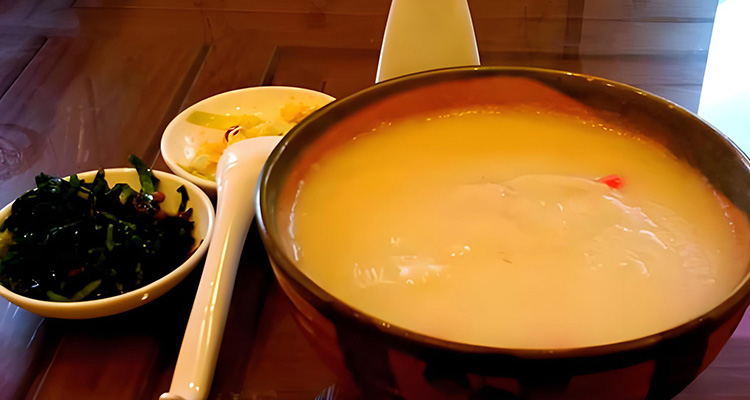traditional Chinese breakfast :Fu Shan Tounao
In the cold mornings of Taiyuan, a steaming bowl of Fu Shan tounao is more than breakfast—it’s a centuries-old warming ritual. This thick, savory porridge-like stew blends lamb, roasted flour, yam and lotus root with medicinal herbs, offering a comforting taste and a living slice of Shanxi culinary history.
1. Origin and History: A Scholar-Physician’s Recipe
Fu Shan tounao traces back to Fu Shan (傅山, 1607–1684), a scholar, calligrapher and physician active during the Ming–Qing transition. According to local lore, Fu Shan created this nourishing dish to care for his ailing mother, applying the Chinese principle of “food as medicine.” Originally called an “Eight-Treasure Soup,” the recipe evolved in Taiyuan inns and teahouses and came to be known locally as “tounao” (literally “head/mind”), implying food that restores energy and clarity.
2. Cultural Significance: Breakfast as Medicine
In Shanxi, breakfast often carries a medicinal logic. Tounao is a classic example of this “dietary therapy” approach: it warms the body, strengthens the spleen and dispels cold—qualities prized in northern China’s chilly months. For many Taiyuan locals, a morning of “one bowl, one cup, one small plate” (a bowl of tounao, a small pot of warm yellow wine, and a salty vegetable) is a ritual that balances flavor with wellbeing.

3. Key Ingredients: Simple, Purposeful, Local
A genuine Fu Shan tounao depends on balance:
- Main: tender lamb with some fat for richness; local Chinese yam (shan yao); crisp lotus root.
- Herbal notes: astragalus (huangqi) for qi support; dried ginger or galangal (liangjiang) for warmth; a splash of yellow wine.
- Thickener: “wei mian” (roasted or toasted flour) gives the stew its distinctive creamy body.
The combination yields a warming, mildly sweet-savory profile rather than an overpowering medicinal taste.
4. Cooking Method: Patience and Craft
Making tounao is a slow, careful process:
- Simmer lamb gently for hours to extract a clear, flavorful broth.
- Prepare yam and lotus root—peeled and cut—so textures remain contrasting: soft yam and crunchy lotus.
- Roast flour slowly until fragrant to create wei mian; whisk into the broth to thicken.
- Add herbal elements and rice-wine toward the end, then return meat and roots to simmer until flavors unify.
Traditional kitchens start this work before dawn to serve fresh bowls at breakfast.
5. Flavor and Texture: Layered and Comforting
The first spoonful reveals a silky, full-bodied mouthfeel. Lamb’s umami meets the toasty grain aroma of roasted flour; underlying herbal warmth from astragalus and ginger adds subtle depth. Yam lends a gentle, velvety note while lotus root provides light crunch—resulting in a balanced, restorative experience rather than intense saltiness.

6. How to Eat It: Local Pairings
Tounao is rarely eaten alone. Typical accompaniments include:
- A small pot of warmed yellow wine to enhance circulation.
- Salted or quick-pickled chives to cut through richness and refresh the palate.
- Hat-box flatbread pieces or lamb shaomai (steamed dumplings) to soak up the broth.
Locals will tear bread into the bowl and sip; this communal, unhurried style is part of the charm.
7. Where and When to Try It: Best Tasting Tips
- Timing: Tounao is a true breakfast dish—most shops serve it from early morning until mid-morning and sell out quickly. Plan to visit between 6:00–9:30 AM.
- Where: Seek century-old eateries and Taiyuan’s traditional breakfast stalls—these places retain classic recipes and cooking methods.
- Mindset: Be open to herbal nuances. The warming, nourishing effect may become your favorite winter ritual.

8. Practical Tips for Travelers
- Cost: A standard tounao set (bowl, small wine, a side) typically costs modestly—affordable at most local shops.
- Ordering: Ask for “one set of tounao” in English or show the dish name in pinyin: “tounao” or “Fu Shan tounao.”
- Seasonality: It’s especially popular in autumn and winter but you can find it year-round in traditional outlets.
9. Simple Home Version: Recreate a Taste of Taiyuan
If you want to try a home-friendly version:
- Use pre-cooked lamb and store-bought lamb broth or stock.
- Pan-roast a small amount of plain flour until fragrant, then whisk into simmering stock for thickness.
- Add sliced yam and lotus root; simmer until tender.
- Season with a splash of yellow rice wine, a pinch of dried ginger and a little powdered astragalus (available at herbal shops).
- Finish with lamb pieces; serve with pickled chives or steamed buns.
This simplified method won’t fully replicate an old teahouse’s depth but captures the essential warmth.

Conclusion: A Morning Worth Getting Up For
Fu Shan tounao is a delicious intersection of history, medicine and everyday life in Taiyuan. For visitors to Shanxi, the dish offers both sensory pleasure and cultural insight—an edible welcome to the region’s traditions. Next time you’re in Taiyuan, rise early, step into a historic breakfast stall and order a bowl: it’s a small adventure that fills you with warmth and history.


